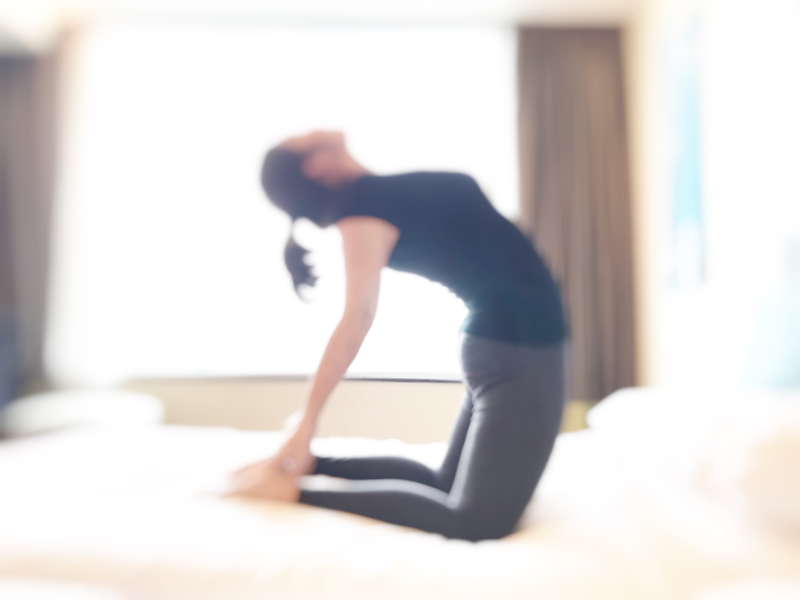
Yoga Poses for Athletes
2nd February 2018
Energy Vampires
7th February 2018Yoga Poses to Balance the Nervous System

In addition to benefitting our physical health, regular yoga practice can drastically improve our mental clarity, too. Through a series of restorative postures, the alternative therapy can balance the nervous system and allow us to enjoy a life of self-awareness and a sense of ease. In this article, we explore some of the most effective yoga poses to balance the nervous system. Before beginning, it’s worth picking up a comfortable yoga mat to practice on.
Supported Bridge Pose
Great for balancing the nervous system, Supported Bridge Pose keeps your head below your heart. Additionally, this simple posture can benefit the digestive system, too. Nerve cells of the parasympathetic nervous system are situated in the sacral section of the spinal cord. In Supported Bridge Pose, a block is used to place light pressure on this area to stimulate the rest and digestive response.
Start this pose laying on your back, bending your knees whilst keeping the soles of your feet touching the ground. Relax your arms, letting them drop carefully to the sides of your body. Tuck your chin into your chest then lift your hips your hips off the floor. Finally, slide a yoga block directly under your lower back. You are in Bridge Pose. Hold for 30 seconds before removing the block and lowering your back and buttocks back down to the ground. For a more intense stretch, practice a higher lift by rotating the yoga block.
Supported Half Frog Pose
Supported Half Frog Pose works to open up your hips, inner thighs, and pelvic floor. For best results, use a pillow or blanket as support during the posture – especially if you have sensitive knees. To begin the asana, lie flat on your stomach with your pillow placed on the right side of your body, in line with your hips. Next, stack your hands on top of one another and rest your head on the back of them. Bending your right knee at around 90 degrees, bring your right leg out in line with your hip. The inside of your right thigh should now be resting on your pillow. You are in Supported Half Frog Pose. To increase the stretch, slowly draw your knee up towards your armpit. Hold the posture for 30 seconds before repeating on the opposite side.
Supported Child’s Pose
One of the best ways to balance the nervous system is by releasing all muscular tension. The restorative posture known as Supported Child’s Pose is ideal for achieving this. For best results, practice this pose with your eyes closed and the lights turned down; this action reduces sensory stimulation and allows the body to completely relax. Before beginning the pose, make sure that you have a blanket or pillow to hand. If your pillow is not long enough to support the entire front of your body, consider using a couple for best results.
To begin the pose, kneel down on your mat with your pillow laid out in front of you. Next, sit back on your heels and lengthen the spine as you inhale. As you exhale, slowly walk your hands out in front of you until your chest is touching your pillow. Finally, rest your forehead on the pillow and place your arms by your sides. You are in Supported Child’s Pose. Hold the pose for around 5 minutes, or as long as the posture feels comfortable. To balance the digestive branch of your nervous system, try practising a wide-kneed Child’s Pose to relax the pelvic floor.

Waterfall Pose
A softer variation of the posture known as ‘Shoulder Stand’, Waterfall Pose is great to incorporate into your restorative routine. Unlike Shoulder Stand, Waterfall Pose doesn’t invert your uterus; this means that the posture is safe for women to practice during their menstrual cycle. To make the pose easier, consider practising with your bottom touching a wall.
To begin Waterfall Pose, lie on your mat facing the ceiling. Bend your knees and rest your feet flat on the mat, as if you are preparing for Bridge Pose. Pressing your feet firmly into the floor, lift your hips up and place a block underneath your lower back. One at a time, draw your knees in towards your chest and then lengthen them straight up. If you are practising the posture against a wall, both legs should now be resting against it. You are in Waterfall Pose. Hold the posture for 30 seconds whilst breathing deeply.
Corpse Pose
Highly effective and simple to practice, many yogis use corpse pose at the end of their routine. Encouraging the body to completely relax, this restorative posture is a great way to balance the nervous system. All you need to do is lie down on your back, relaxing your arms by your sides while keeping both legs stretched out. You are in Corpse Pose. Take this time to concentrate on your breathing for as long as you feel happy doing so. Additionally, this pose can balance the digestive branch of your nervous system. Try bringing your knees in toward your chest before allowing your legs to straighten to the ground. This simple step will help eliminate gas by stimulating the nerves in the colon.
In Summary
Whether you’re hoping to reduce stress and anxiety or you’re more interested in using yoga to improve insomnia, practice the restorative sequence above to reap the benefits. For best results, it’s important to wear a loose fitting yoga top when practising these postures. Restrictive clothing can make it harder for the body to relax, therefore reducing the positive effects of the asanas.

